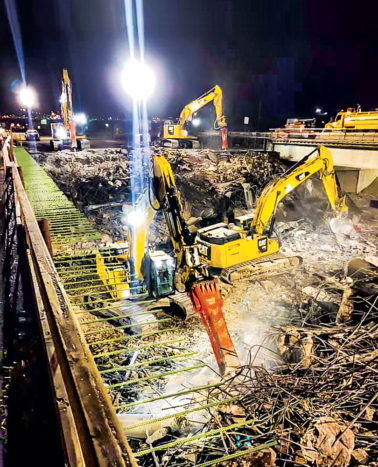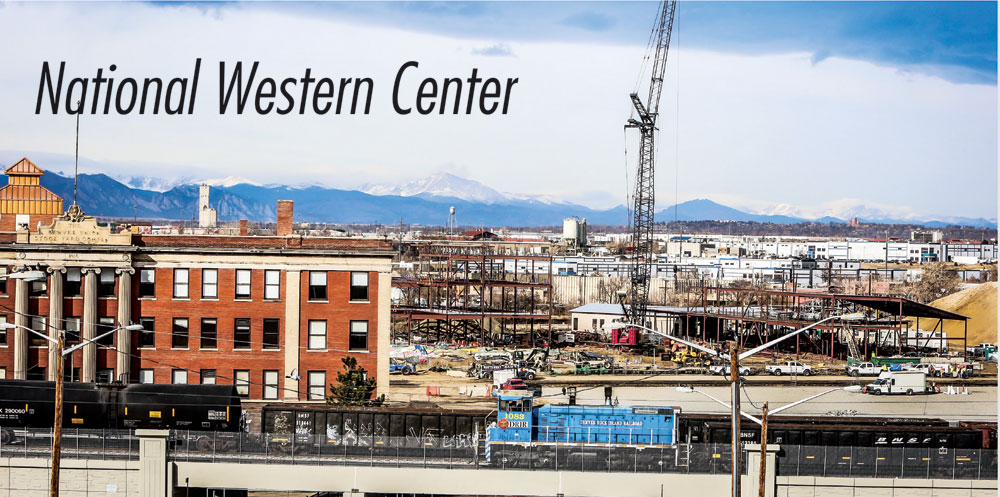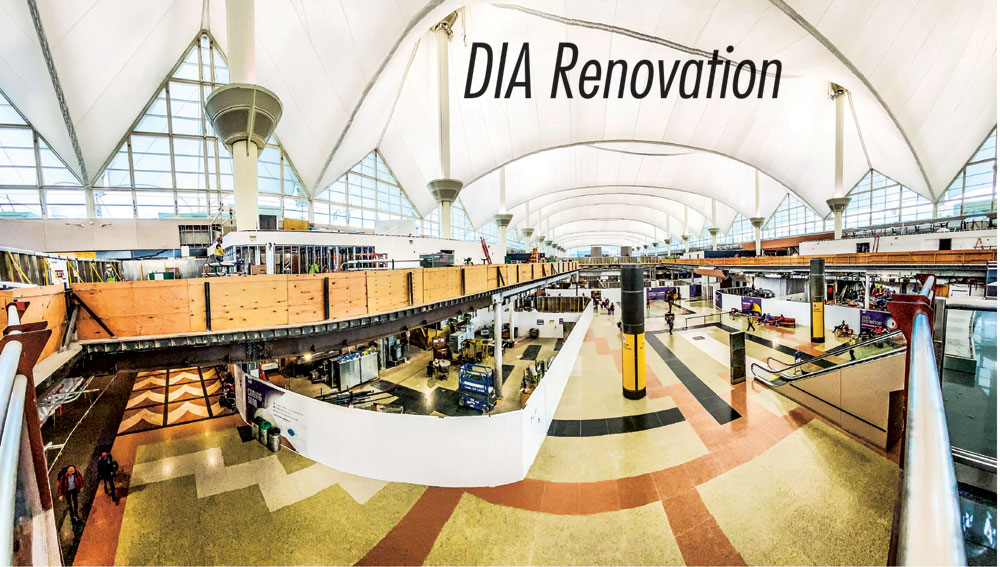

The new I-70 bridge over Quebec was built over the original bridge. Quebec closed Friday night Jan. 8, and by Sunday morning the entire old bridge had been torn out and removed. Photo courtesy of CDOT
While some of us ate, slept, worked, schooled, and recreated within the same four walls for much of the past year, NE Denver residents who frequented I-70 from Brighton Blvd. to the airport saw massive changes. Three separate multi-year billion-dollar projects provided much-needed employment during the pandemic and, at times, progressed faster because so many people and their cars were at home.
National Western Center
What is it and why is it happening? To fund improvements necessary to keep the iconic Stock Show in Denver, voters in 2015 overwhelmingly approved Ballot Measure 2C that extended a tax on hotel rooms and rental cars. In addition, by expanding the grounds, a year-round arts, entertainment, education, and research center is also being developed there through a funding partnership between the City and County of Denver, Western Stock Show Association and Colorado State University. The National Western Center Authority is a new nonprofit that will operate, maintain, program, and promote the campus. Denver Museum of Nature and Science and History Colorado will provide additional programming.

Trains pass through the future National Western Center on the newly constructed rail corridor with the historic Livestock Exchange Building in the background. Construction continues on the Colorado State University Spur campus, which consists of three buildings and opens in 2022.
How big is it? The original 110-acre grounds are being expanded to roughly 250 acres. By the projected completion of phases 1 & 2 in 2024, the National Western Center will have new and expanded indoor and outdoor spaces including state-of-the-art facilities, historic buildings, and riverfront open space. Additional phases are planned for the future.
How is it funded? The biggest chunk of funds for the 1.2 billion dollar project, about 62%, comes from ballot measure 2C; about 25% comes from CSU for construction of its three buildings; and about 12% comes from a Regional Tourism Act award from the State of Colorado, paid over 36 years.
Some unique features: In addition to new Stock Show facilities, 1) It will be a 21st century, year-round agricultural research center to advance global knowledge about food, water, and health. 2) It will have the largest sewer-heat recovery system in North America—a system that pulls thermal energy from wastewater instead of burning natural gas, dramatically reducing greenhouse gas emissions. 3) It will have six acres of family-friendly public open space near the South Platte riverfront for recreation and relaxation.
How did the pandemic affect the project this year? And in the future? Following the tough decision to cancel the Stock Show due to the pandemic, “…we were actually able to make an opportunity out of it by advancing the construction,” says Tykus Holloway, Executive Director of the Mayor’s Office of the National Western Center. Without crowds and livestock, crews continued work on site drainage, relocating railways and utilities, and getting pad sites ready for construction. They followed protocols for Covid-19 and had no outbreaks or slowdowns due to the pandemic. “Right now, the 2021 schedule remains as planned,” says Holloway, which includes a bridge over the Platte River, new roadways, and completing the new Stockyards Event Center. Looking further ahead, Holloway acknowledges revenue from the tourism tax and entertainment venues has been impacted and says the City Dept. of Finance will balance the best timing to release bonds with the project’s need for funds to proceed with construction.
Central 70
What is it and why is it happening? 200,000 vehicles a day currently traverse the 10-mile stretch of I-70 from Brighton Blvd. to Chambers Rd. and demand is increasing—but deficiencies exist in the old infrastructure and it lacks the capacity to handle projected future demand.

The bridge over Quebec is one of 20 new bridges being built on or over the highway in the 1.2-billion-dollar Central 70 project to be substantially completed by the end of 2022.
This 10-mile stretch is being reconstructed to add one new express lane in each direction, remove the aging 57-year-old viaduct, lower the interstate between Brighton and Colorado boulevards, and place a park over a portion of the lowered interstate. Substantial completion is projected for end of 2022.
How big is this project? 20 bridges are being built, and nearly 37,000 linear feet (or about 7 miles) of new sidewalk will be added with the new bridges and roadways including at Colorado, Dahlia, Holly, Monaco, Quebec, and Peoria. Wide shoulders are being added for stalled or emergency vehicles
The 1.2 mile viaduct will be torn down and traffic (starting in 2021) will move to the new roadway that gradually goes down 60 feet lower than the current viaduct height (30 feet underground). A 3-block long tunnel will be built in the lowered roadway—and a 4-acre park above it will reconnect the Elyria and Swansea neighborhoods that got separated when the I-70 viaduct was built.
A new express lane system with transponders will let drivers choose a reliable trip for a toll or a general-purpose lane for free. Carpoolers (3+ people) and motorcyclists are free.
How is it funded? This $1.2 billion project is funded the Colorado Bridge Enterprise (76%), Senate Bill 228 (16%), Denver Regional Council of Governments (DRCOG) (5%), and the City and County of Denver (3%).
Some unique features: 1) As a public-private partnership, Kiewit Meridiam Partners will operate and maintain the highway for 30 years after completion. 2) Toll rates will be based on keeping the right number of vehicles in the express lanes so travel times are reliable. 3) Swansea Elementary, located next to the viaduct demolition site, got an $18.5 million renovation. 4) The community was given a $2 million grant to build affordable housing. 5) 56 residences and 17 businesses in the project right-of-way were acquired by CDOT. 4) The 4-acre park will include sports fields, water features, playground equipment, and other amenities requested by the community.
How did the pandemic affect the project? The governor deemed construction to be essential so the project was not interrupted and hiring continued through the year. Workers followed CDC guidelines and no Covid-19 outbreaks occurred that slowed progress. Workers were divided into crews; if a crew quarantined after a positive exposure, only a small group ended up at home on sick leave.
Project funding was not impacted by the pandemic. With lower traffic volume, Quebec to Chambers got paved in daylight hours, offering much safer conditions for workers than nighttime work.
Denver International Airport
What is the project and why is it happening? The airport (DEN), now 25 years old, was built for 50 million annual passengers. Pre-pandemic it reached 69 million and was projected to hit 80 million by 2025 and 110 million by 2040.

The pandemic has reduced the number of people in the Great Hall, as shown here at mid-day in mid-January. Fewer travelers meant much of the renovation and expansion work could be done during daylight hours rather than on night shifts
Phase I of DEN’s Gate Expansion Program (to be completed in 2021) is building 39 new gates and renewing concourse infrastructure. Phase II concourse improvements (to be completed in 2024) will include renewing restrooms and furnishings and installing new moving walkways and escalators.
Phase I renovation of the Great Hall (to be completed in 2021) is adding four ticketing areas with a total of 82 self-bag drops for United and Southwest, upgrading restrooms, and adding space to improve passenger flow and security. Phase 2 (starting in the summer of 2021) will move the south screening area from level 5 to level 6, make the screening area more secure, and upgrade screening technology.
Size of the project? Each concourse will be expanded by several thousand square feet, increasing gate capacity by 30%. The Great Hall, which has 1.5 million square feet, is adding 16,000 sq. ft. for passenger screening. DEN is the 5th busiest airport in the U.S. and the 20th busiest in the world.
How is it being funded? All projects are part of a $3.5 billion capital improvement program funded by airport bonds. The Gate Expansion cost is $1.5 billion, the concourse renewal is $560 million, and the Great Hall is $770 million.
Some unique features: 1) Concourses A & B west, with all new gates going to United, will have a new outdoor deck with views of the mountains, a pet relief area, outdoor seating and fire pits. 2) Concourse C east, with all gates leased to Southwest, will have an outdoor deck with the same amenities and a view of the prairie.
How did the pandemic affect the projects? More than 1,000 people a day worked on DEN’s projects. With strict safety measures, they had no work stoppages due to Covid-19. The gate extension work was not impacted by the pandemic since it was an areas with no passengers. With TSA work in the Great Hall could be done during the day, rather than at night, with the lower passenger numbers, and was finished ahead of schedule.
Being a good outdoor destination, DEN had 12 to 15 percent more passengers than the average for U.S. airports—and it has many domestic flights, which were less impacted than international flights. Though 2020 passengers were 60% of 2019’s level, DEN had a 500-day cash-on-hand cushion to weather it. DEN offered relief packages to stakeholders in 2020 and in 2021, which eliminated the minimum guarantees in contracts and deferred lease payments.
DEN project information provided by Alex Renteria, Emily Williams and Shellee Casiello.



0 Comments